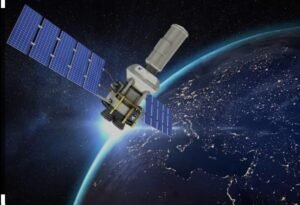what is satellite
Satellite Technology: An Overview
Satellites are artificial objects placed in orbit around celestial bodies, primarily the Earth, for various purposes, including communication, navigation, weather monitoring, scientific research, and military applications. Since the launch of Sputnik 1 in 1957, satellite technology has revolutionized how humans interact with space and Earth, significantly impacting industries and everyday life. This article explores satellite technology, its types, functions, applications, and future advancements.
Types of Satellites

There are many different types of satellites, each designed for a different purpose. The primary categories include:
1. Communication Satellites – Facilitate telecommunication, broadcasting, and internet services by transmitting signals across vast distances.
2. Navigation Satellites – Provide positioning, navigation, and timing (PNT) services, forming systems like the Global Positioning System (GPS).
3. Earth Observation Satellites: These satellites use remote sensing to keep an eye on environmental changes, natural disasters, and patterns of land use.what is satellite
4. Weather Satellites – Track and predict meteorological conditions, assisting in weather forecasting and disaster management.
5. Scientific Satellites – Conduct research on space, astrophysics, and planetary sciences, contributing to our understanding of the universe.
6. Military Satellites – Support defense and intelligence operations through surveillance, reconnaissance, and secure communications.
7. Exploration Satellites – Travel beyond Earth’s orbit to study celestial bodies such as Mars, Jupiter, and distant asteroids.
How Satellites Work
Satellites function through a combination of components that enable them to operate effectively in space. These include:
Power System – Solar panels and batteries generate and store energy.
System of Communication:
Transponders and antennas make it easier to send and receive signals.
Propulsion System – Thrusters adjust the satellite’s orbit and position.Instruments collect and transmit mission-relevant data for the satellite’s sensors and payload.
Onboard Computer – Manages satellite operations, including navigation, communication, and data processing.
Satellite Orbits
Satellites are positioned in various orbits depending on their mission. The major types include:
1. Low Earth Orbit (LEO) – Positioned at altitudes of 160–2,000 km, LEO satellites are used for Earth observation, imaging, and communication.what is satellite
2. Medium Earth Orbit (MEO) – Located between 2,000 and 35,786 km, primarily used for navigation satellites like GPS.
3. Geostationary Orbit (GEO) – At 35,786 km, these satellites appear stationary relative to Earth, making them ideal for communication and weather monitoring.
4. Highly Elliptical Orbit (HEO) – Used for specialized missions requiring extended coverage over polar regions.
Applications of Satellites what is satellite
Communication
Satellites facilitate global connectivity by enabling:
Television broadcasting
Internet services in remote area’s
Networks for mobile and telecommunications
Emergency communication during disasters
Navigation and Global Positioning
Navigation satellites power location-based services, benefiting:
Transportation and logistics
Aviation and maritime industries
Search and rescue operations
Autonomous vehicles
Weather Forecasting and Climate Monitoring
Weather satellites provide crucial data on:
Storm tracking and disaster prevention
Climate change and global warming patterns
Ocean currents and temperature changes
Remote Sensing and Earth Observation Earth observation satellites support:
Agricultural planning and resource management
Environmental monitoring and conservation
Urban planning and infrastructure development
Disaster response and mitigation
Scientific Exploration
Satellites expand human knowledge through:
Space telescopes like Hubble studying distant galaxies
Planetary exploration missions, such as Mars rovers
Cosmic radiation and gravitational wave research
Defense and Security
Military satellites contribute to national security by:
Surveillance and reconnaissance
Systems for warning missiles Secure military communications
Satellite Technology’s Obstacles Despite its advantages, satellite technology faces several challenges:
Space Debris – Increasing amounts of defunct satellites and debris threaten operational spacecraft.
High Costs – Manufacturing, launching, and maintaining satellites require substantial investments.
Cybersecurity Threats – Satellites are vulnerable to hacking and cyber-attacks.
Orbital Congestion – The growing number of satellites increases the risk of collisions.
Signal Interference – Atmospheric conditions and space weather can disrupt satellite communication.
Regulatory Issues – International regulations and agreements govern satellite deployment and frequency allocation, making compliance complex.
Lifespan and Upkeep: Satellites have a short lifespan and require costly upgrades or replacements.
Future of Satellite Technology
The future of satellite technology is promising, with advancements such as:
Miniaturization – Development of small satellites (CubeSats) for cost-effective missions.what is satellite
Reusable Launch Vehicles – SpaceX and other companies are making space travel more affordable.
AI and Automation – Enhancing satellite autonomy for better data processing and decision-making.
Quantum Communication – Securing satellite-based communication with advanced encryption.
Interplanetary Satellites – Missions aimed at deep space exploration and planetary colonization.
5G and Next-Generation Networks – Satellites will play a crucial role in global 5G and future 6G connectivity.
Space-Based Solar Power – Future satellites may harness solar energy in space and transmit it to Earth.
Conclusion
Satellite technology is a cornerstone of modern civilization, playing a vital role in communication, navigation, scientific research, and security. As technology advances, satellites will continue to evolve, offering innovative solutions to global challenges and expanding human capabilities beyond Earth. Satellites will play a significant role in shaping the future of our interconnected world as the next frontier of space exploration. With continuous improvements and new discoveries, satellites will remain at the forefront of space innovation, bridging the gap between Earth and the cosmos.
